by Catherine Lim
Canopy by Arron Wilson is a World War Two film shot mainly in Sungei Buloh and Bukit Brown, with flashback scenes that takes viewers to the Australian outback farm from where Jim, the Australian fighter pilot – one of only 2 lead characters – is from. It has a script which consists of a few phrases of incoherent Hokkien spoken by Seng, the Chinese resistance fighter – incoherent perhaps because my rudimentary Hokkien could not grasp it – a smattering of Japanese dialogue among patrolling Japanese solders for which they were no subtitles, and Jim himself as I recall spoke nothing more than his own name through out.
But it did not matter, because the cinematography draws us into the depths of the landscape of war set in lush, verdant green as if we were there, and the sound scape of gunfire, bombs, distorted bird and insects calls, , the menacing rustling of undergrowth and the silence of the jungle tells the story of a bond that is formed over just one night.
Canopy unravels the story of of 2 lone young fighters, from two vastly different cultures – where even the sound of their names Jim and Seng are so alien to each other’s tongues – running into each other, caught in the bewildering jungle of war and what happens reaches spirituality.
There is an eye averting sequence when Jim tends to the wounds of Seng, and is forced to gag his screams as the Japanese soldiers patrol pass. The mirror scene is when Jim relives his nightmare of falling into the canopy of trees and he wakes up with Seng’s hand over his mouth. Seng is watching Jim even as he sleeps, the same way Jim had watched over Seng.
They are drawn together by a common enemy but more than that, faced with fear, pain and ever present danger, they find in each other more than just comfort and respite.
Something quite extraordinary is experienced between Jim and Seng which passes in the moments of silence and solitude in the jungle. They bond in a way that plunges into their stream of consciousness even as the camera plunges the depths of the jungle. It is as if they had a shared past in the flashback of the farm Jim lives in and in the black the white photograph of Seng’s parents. It is intimate, it is visceral.
War destroys lives but war is also the great leveler , breaks down the divide of colour, culture, race and religion, and forges a connection that unites humanity and uplifts the spirit in endurance and compassion.
The story of Jim and Seng is not an unlikely story, it is a story that could have happened in the 3 years of Japanese Occupation in Singapore between 1942 and 45, it is a story that surely must have happened with the same intensity, in some corner of war- torn Singapore. It is a story among many others, waiting to be uncovered.
The time has come to reclaim our past.
“Lest we forget”
************************************
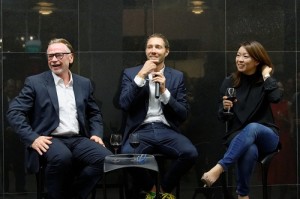
Ambassador Philip Green. Aaron Wilson and Pek Lian in animated discussion with audience. (photo courtesy of Australia High Commission)
Catherine was invited under All Things Bukit Brown to a private screening of the film as a guest of the Australian High Commission A short discussion followed with producer Aaron Wilson and local film maker Pek Lian who produced Synonara Changi which covered the theme of war remembrance.
Next year, All Things Bukit Brown will commemorate the 70th Anniversary of the Liberation of Singapore from Japanese Occupation.
Saturday 27th Dec’2014 9am – 12pm
Meeting place: At the Lor Halwa Main gates
Join the Brownies for the last guided walk of 2014, as they look back at their journey and share their collection of individual stories and experiences at their favourite tombs: stories of women breaking the glass ceiling, of great sacrifices and humble deeds, experiences of the joy of discovery and connecting the living to the dead. It is also our thank you tour for the community who have supported us all the way through this ongoing journey which began in 2011, of bringing our collective past and history into the present. We look to you to continue to grow and spread the word of Bukit Brown a Living Museum, Heritage Habitat History.
Bukit Brown Advocate Organisation of the Year 2014
http://bukitbrown.com/main/?p=9425
Bukit Brown on the World Monuments Fund Watch List
http://bukitbrown.com/
Please sign up at Peatix: http://atbb2.peatix.com/ if you are coming!
We guide rain, shine or exhumations”
==========================
Please bring umbrella or poncho and sun protection.
Please wear covered footwear.
Please bring mosquito repellent.
————————–
For first time visitors, see below for some important things to note.
==========================
For information on how to get there and handy tips please visit
http://bukitbrown.com/
Disclaimer: By agreeing to take this walking tour of Bukit Brown Cemetery, I understand and accept that I must be physically fit and able to do so.To the extent permissible by law, I agree to assume any and all risk of injury or bodily harm to myself and persons in my care (including child or ward)
Registration:
Our weekend public tours are FREE …
Optimally the group size is 30 participants (15 individuals/guide).
==========================
Bukit Brown:
The Bukit Brown area is about 233 hectares in extent, bordered by Lornie Road, Thomson Road and the Pan-Island Expressway. It lies just to the south of the Central Catchment Forest, being separated from it by Lornie Road and includes Singapore’s only Chinese Municipal Cemetery. With more than 100,000 graves, Bukit Brown is also one of the largest Chinese cemeteries outside of China.
Don’t forget to bask in the peaceful surrounds, and also chat with your guides and make friends with other participants. We are amateurs and volunteers, but we are passionate and serious about what we do at Bukit Brown, and we encourage sharing of knowledge.
Here is a map of the grounds:
http://bukitbrown.com/
==========================
Please take note:
1. We will be walking mainly on paved roads. But there are hill treks so dress appropriately, especially your footwear.
2. Wear light breathable clothing. Long pants and long sleeves if you are prone to insect bites or sunburn. Bring sunblock and natural insect repellent.
3. Wear comfortable non-slip shoes as safety is important. Walking sticks are recommended.
4. Do read up on Bukit Brown before going so you have a better understanding of the place (e.g. BukitBrown.com)
5. Do bring water, light snacks, poncho/umbrella, sunhat and waterproof your electronics.
6. Please go to the toilet before coming. There are NO facilities anywhere there or nearby.
==========================
How to get there by MRT / Bus:
Bus services available: 52, 74, 93, 157, 165, 852, 855.
From North: Go to Marymount MRT and walk to bus-stop #53019 along Upper Thomson Road. Take Buses 52, 74, 165, 852, 855
Alight 6 stops later at bus-stop, #41149, opposite Singapore Island Country Club (SICC), Adam Road. Walk towards Sime Road in the direction of Kheam Hock Road until you see Lorong Halwa.
From South: Go to Botanic Gardens MRT and walk to bus-stop #41121 at Adam Road, in front of Singapore Bible College. Take Buses 74, 93, 157, 165, 852, 855. Alight 2 stops later at bus-stop, #41141, just before Singapore Island Country Club (SICC), Adam Road. Cross the bridge, walk towards Sime Road, follow the road until you see Lorong Halwa.
By car:
Turn in from Lornie Road, to Sime Road. Then, turn left into Lorong Halwa.
Parking space available along Lor Halwa and in the cemetery some distance after the cemetery gate
Dunman Secondary School brought around 40 students to Bukit Brown on 16 August 2014 for a learning journey. Our students marveled at the vast, rich sloping terrain covering over 200 hectres of land space. Some graves dot all the way to Mount Pleasant Road (along PIE).
Our students know that Joo Chiat and Boon Lay are familiar residential estates but little did they know them to be named after our pioneers who lie buried at BB. Tan Ean Kiam, the pioneer whose foundation donated to the construction of our school hall, lies buried at BB alongside his wife. Our students observed a minute of silence as a mark of respect for him.
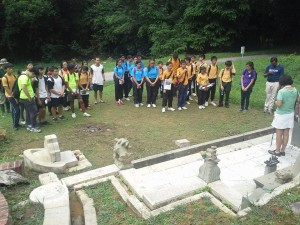
Dunman Secondary School students observing a minutes silence at the grave of Tan Ean Kiam (photo Yik Han)
Our students learned about the strong cultural links our pioneers had with China expressed in the Chinese poetry and the rich artistry in the sculptures and carvings on their grave stones.
The ultimate aim of education is known to be character-building, but certain values such as filial piety and fortune expressed in an abundance of descendants and sustaining blood lines, are so deep-seated that our pioneers bring them down to their graves in forms of figurines symbolizing these values. One grave had carvings showing a a daughter in law breastfeeding her aged and toothless- mother-in-law, choosing to feed her over her crying child, in an act of filial piety. Another grave had 2 Sikh guards standing erect and tall each by the side of a rich tycoon’s final abode. He even had them enshrined as a “sepoy” (stationary guard) and a “prowler” (one who patrols around). This setting reveals the trust placed on the Sikhs for protection during colonial times. Our students were amazed by the detail and rich history of Bukit Brown.
Our students learned that war time graves were smaller and have a unique serial numbering. They were also informed that mass graves were a norm during the Japanese occupation from 1942 to 1945.
We offer our deep heart-felt thanks to the brownies ( the Bukit Brown volunteers) Yik Han, Beng Tang and Catherine for an informative and educational tour of BB. Their passion and love for the history and heritage of the pioneers is evident during their explanations and guidance of the tour. We truly believe that Dunmanites in the tour benefited greatly from the sharing and discussions.
By Gopie Silvarajoo Naidu Prem ( Teacher in Charge)
Editors Note:
The students were from the schools NPCC. Their teachers had worksheets which they worked on immediately on-site after the guided walk. The learning journey was documented and later published in their newsletter. We thank the teachers especially of Dunman for going the extra mile to do this despite their very busy schedule. We note that this was the third time the school has requested engagement on Bukit Brown with Brownies for various groups of students. There was one previous visit to Bukit Brown and a brownie had also made a presentation on Bukit Brown at the school itself.
Thank you for sending atBB the PDF of the newsletter.
Schools who are interested in learning journeys, please email a.t.bukitbrown@gmail.com. and give us least 3 weeks notice.
Catherine Lim
1
by Perry Tan
Standard Chartered Bank
In April 2014, in collaboration with All Things Bukit Brown, we conceptualised a guided walk with a Clean-Up at Bukit Brown, where a team of 35 volunteers from Standard Chartered were taken on a guided tour, before spending up to 4 hours cleaning tombs. The organising committee were initially ambivalent about volunteer response and feedback, since such an unique CSR (Corporate Social Responsibility) event at a cemetery was previously unheard of. Our ambivalence proved to be unfounded, as we were pleasantly surprised and heartened by the very positive volunteer feedback. This prompted us to plan 2 additional sessions for the year.
So on a cloudy but dry Saturday morning (13 Sept’2014) , we found ourselves back at Bukit Brown five months after our inaugural CSR event at the heritage cemetery. Read Perry’s report on Standard Chartered Bank’s first CSR @ Bukit Brown here.
The programme was similar – starting with an hour-long tour the tombs of prominent pioneers guided by Claire Leow, co- founder of All Things Bukit Brown (bukitbrown.com) , followed by a clean-up of tombs* in various stages of clean up needed, hand-picked by brownie Khoo Ee Hoon. A few of the volunteers were repeat volunteers, who found the initial session April so enriching that they came back for more. Although we used the same programme, the beauty of Bukit Brown is that it is so rich in history that our guide easily customised our tour to be different from the first one by simply taking a new route and stopping by the tombs of different pioneers.
The presence of repeat volunteers meant that we had a cleaning crew that was semi-experienced. We identified 3 cleaning clusters, two of which were heavily covered with undergrowth and trees. Volunteers were split into 3 teams, with those who were stronger and more experienced assigned to the more challenging clusters. The result was excellent – we were faster, more efficient and managed make quick work of heavy vegetation in our way. We even sawed down and uprooted quite a number of small trees that some of us could now moonlight as lumberjacks!
The day ended up with a light hike up to Ong Sam Leong’s magnificent tomb, where we were treated to a King of the Hill view of Bukit Brown, ornate designs of the tomb and stories of the Ong clan.
We went home sweaty and slightly filthy, but fulfilled by the meaningful work we did. Once again, a few volunteers enjoyed the experience so much that they indicated their interest to join us again in the next round – this certainly is starting to look like a sustainable CSR initiative that brings a very progressive heritage ring to tthe Bank’s “Here for Good” brand promise!
Here’s what some volunteers had to say about their experience…
“It was a very nice experience, learning about the history of Singapore, and the people who built Singapore and gave opportunities to many others who follow. It is a very historical area – good place to visit for the people who want to know more about the history and preserve it.” Hari Natarajan
“I am very glad to be part of the team and it was a wonderful experience. I learnt a lot about Singapore’s history and enjoyed the physical exercise as well. Although the event dealt with graves, there was no taboo, but actually fun. And I think this heritage and history theme goes well with our slogan of “Here for Good”. We remember history, we are here for good.” Ye Yang
Editors note:
*Tombs selected for cleaning are those which – for reasons unclear – have been forgotten and have not been visited for a number of years. One reason shared with us by descendants who have been recently reunited with their ancestors, is the main caregivers had themselves passed on. In respect for the tomb keepers whose livelihoods for generations are dependent on the services provided to descendants, All Things Bukit Brown, to the best of its abilities, ensures that no tomb selected for volunteer cleaning is not under the care of tomb keepers. Our hope is that a tomb once cleared will reveal information that will trigger a memory which will lead to a reunion. We believe in Serendipity because it has happened.
We are heartened and encouraged by the experience of Standard Chartered Bank and thank them for initiating this project. If you are corporation or a community group and are interested in sharing their experience, please drop an email to a.t.bukitbrown@gmail.com. Subject Title: ” CSR @ Bukit Brown Programme”
The Story Behind Peg 2906
by Norman Cho
How many of us believe in the unexplained? There are reasons why certain things happen unexpectedly. But are we receptive enough to take the cue from such signs? One recent account was of tomb 481 which was pegged 2906 at Bukit Brown Cemetery, slated for exhumation to make way for the 8 lane highway due to slice the cemetery in half by 2017/
A post about the Ee Hoe Hean Club in the Facebook page of Heritage Singapore – Bukit Brown Cemetery, spurred me to do a search on my granduncle, Mr Tan Kay Tiang (ie) the husband of my paternal grandmother’s second sister, Mdm Yeo Say Neo. Grandmother had once told me that he worked for an exclusive millionaires’ club called the Ee Hoe Hean Club. No details of the position which he held or the period where he was under their employment were given.
Out of curiosity, I did a Google search over the internet and found to my astonishment that he was buried in Bukit Brown Cemetery and that his tomb was marked for exhumation with the peg number 2906.
I made a few enquiries and discovered that the tomb had yet to be claimed and that it was due for exhumation in only three weeks! I tried to contact the deceased’s three grandchildren unsuccessfully to make a claim. They are in their fifties and sixties and I sensed their reluctance. They probably have their reasons to decide not to do anything about it.
Looking back, I realised that discovering his tomb just three weeks before the exhumation was no mere coincidence! Possibly, he was trying to reach out to someone to handle his exhumation and to relocate him during the desperate final few weeks. I felt very uncomfortable if I did nothing about it and so I decided to claim the tomb on behalf of the family. To make sure that I had identified the correct tomb, I verified the name of his only child on the headstone – 月娘which corresponded with the name of my late aunt, Guek (Guat) Neo. I found a newspaper article in the online digital archive (Newspapersg) which confirmed the identity of the tomb.
Family accounts has it that he died due to septic wound on his foot caused by a nail which he accidentally stepped on. He had concealed nails on the ground along the exterior wall of his house at Neil Road to deter thieves. The irony was not lost on me that these nails were what caused his death, A newspaper report in The Straits Times, 19 June 1938, “Nail Causes Man’s Death” returned a verdict of misadventure. The date of death on the tomb was 10 June 1938.
Tan Kay Tiang married my grandaunt, Yeo Say Neo, in 1923 at his family home in Neil Road. He was 39 and she was 27. During those days when people commonly married in their teens, they were considered an old couple. The couple stayed together with Kay Tiang’s widowed elder sister and his mother.
My grandmother recalled visiting the 3-storey townhouse and was intrigued by the many carpets that she saw on each floor. The couple had their first and only child, a daughter, Guek Neo, in 1925. He was a doting father who was known to piggy-back his daughter till she was nine or ten. The maid would take over after he was tired. As a child, my aunt was thoroughly spoilt and there was an account where the maid was made to walk the dark alley to buy her favorite char siew pau for her supper.
After her father’s death when she was twelve, Guek Neo’s life took a drastic change. She had become a sensible young lady. The house was sold several years later and Guek Neo was arranged to be married to a Baba named Robert Chia, the son of a well-known nyonya medium in the 1920s and 30s who was known by the name “Ah Lian Potong Lemo” She could predict fortunes by reading the sliced limes.
Mrs Tan Kay Tiang (Yeo Say Neo) was the ideal wife and homemaker. She excelled in cooking and sewing. She was soft-spoken and mild-tempered. She did not gamble and hardly stepped out of the house. The maid would run all the family errands and do the marketing. To supplement her living expenses after the death of her husband, she made nyonya kueh which her maid would take to the coffee shop at Joo Chiat Road to sell. She eventually had to let her maid go as she could no longer afford to keep her but the maid was reluctant to leave her and stayed on for a few more years.
***
A footnote:
Every tomb is a repository of personal stories of the family that was left behind
Moving forward 76 years later, I had made a claim for the tomb to be exhumed on 14 July 2014 and the remains to be re interred at Block E0116-202 in Choa Chu Kang Columbarium. It would be easier for me to visit since most of my relatives are placed there. He was buried in the traditional Chinese coffin which was relatively intact and had several funeral artifacts which included miniature clay kitchen utensils and two pieces of circular glass which I suspect could be reading glasses – one concave and the other bi-convex.
About Norman Cho:
Norman Cho is a regular contributor to atBB and guest blogs about his search for his roots and Penanakan material culture. He is the founder of the facebook group Peranakan Material Culture
You can find out more about Norman’s search for his roots here and here and posts about Peranakan culture here and here.
All Things Bukit Brown is pleased to announce that it is the first recipient of the Civil Society Advocate Organisation of the Year Award in the inaugural Singapore Advocacy Awards. This is our acceptance speech at the ceremony on August 30, 2014.
“We are honoured and humbled to have been deemed deserving to receive this award by a dedicated and diverse panel of activists, many of whom have worked tirelessly and for a much longer time on a variety of causes such as foreign worker abuse, AIDS awareness and education, the protection of women’s rights and the championing of the local arts scene.
While we are very much the “new kids on the block” among causes highlighted today, we have stalwarts before us who championed the cause of heritage preservation and protection. We look upon this award as encouragement and affirmation, that what we do in promoting awareness of the Habitat, Heritage and History of the iconic Bukit Brown Cemetery is contributing to the growing voices of concern about how rapid development has resulted in the loss of our old places and a growing sense of alienation of what is home.
Our encounters on the ground talking to and documenting stories from tomb keepers to descendants have been enriching, and our wider Bukit Brown experience has led us to places we have never been, to temples and other areas of cultural and ethnic significance, and in observing the customary rites and rituals which are being practiced today, and further afield to maritime port cities linked to our past. By celebrating the rich diversity of a shared past which is being kept alive by sheer dint of devotion and effort, we find ourselves sharing in a larger collective act of preservation of our culture and identity. We are far from alone.
In receiving the honour of this award, we pledge to continue to engage in conversation and in concert with all stakeholders to make heritage a part of the development paradigm, and to re-imagine spaces which will reinforce memory and identity from one generation to another generation.
We would like to thank especially Raymond and Charles Goh, for leading the way and sharing with us so generously and so passionately all your research from when both of you started exploring Bukit Brown eight years ago. Our abiding gratitude goes to the community especially on Heritage Singapore – Bukit Brown Facebook group which have encouraged and supported us, and which enlivens Bukit Brown daily with the members’ sharing of interesting articles and stories, anecdotes and sometimes grave discussions. It is your enthusiasm that led us all on this journey; unlike most online communities, we are glad to have met many of you face-to-face in on- and off- site events.
We thank the Singapore Heritage Society for nominating us and finally we thank the SAA for this honour, which we will endeavor to live up to. We have much to live up to.
We acknowledge and congratulate all the other nominees. For us, it was enough to have been nominated.
This initiative by SAA makes all of us nominees winners because it celebrates the acts and sacrifices made by volunteers across different communities. Volunteers are the heart of many communities, raising awareness, lifting spirits, affirming shared values, shaping aspirations, and connecting the different threads of society into a fabric that is stronger for weaving its constituents together. Volunteerism is often driven more by passion and purpose than resources, and demands us to be creative, persevering and collaborative. It is often, especially in the nascent stages, lonely and intimidating, confusing and almost crippling in the face of lofty expectations of what a few individuals can and should achieve.
We acknowledge and endorse the efforts of the SAA to bring voices to the communities that need encouraging, causes that need acknowledgement and affirmation, and issues that benefit from airing in public discourse. We do ourselves a service by taking ownership of issues and responsibility for making dreams a reality. This is our contribution to our society. It is humbling to be acknowledged.
Next year, we as a country will commemorate the 50th anniversary of the founding of Singapore as a republic, and the 70th anniversary of the liberation of Singapore from occupation during WWII. We salute all the communities and civil society activists before us who have taken our country to where it is today.”
Claire Leow & Catherine Lim, Co-Founders, All Things Bukit Brown
***

The Brownies with Constance Singam, one of the judges and a highly esteemed civil activist and writer
- T. Sasitharan (Panel Chair) – Arts educator and Cultural Medallion winner
- Cherian George – Academic
- Richard Ho – Architect
- Faizah Jamal – NMP & Environmental Activist
- Sharon Siddique – Consultant
- Constance Singam – Civil Society Activist and Writer
- Wong Ting Hway – Medical Doctor
- Geoffrey Yu – Arts Supporter and Former Diplomat
“Activism and advocacy are the cornerstones of an active and vital civil society movement and the need to establish and protect free space for civil society has never been more urgent than it is now,” said Mr Sasitharan. “A strong civil society will lead to healthy, functioning democracies. Conversely, healthy, well-functioning democracies must allow strong civil societies to exist.”
“If civil society in Singapore is to grow and mature, then it is crucial that good advocacy work that makes an impact on society, that is engaged with the community and that empowers people, should be properly recognised, acknowledged and applauded.” (Source: TOC article here)
The Honours List:
ACRES * All Things Bukit Brown * Braema Mathi * Chan Li Shan * Damien Chng * Eugene Tay * Jeremy Boo and Lee Xianjie * Louis Ng * M Ravi * Pink Dot
Advocate of the Year: Braema Mathi (President of Maruah, a human rights advocacy group)
Advocate of the Year: Louis Ng (ACRES – Animal Concerns Research and Education Society)
Advocacy Organisation of the Year – All Things Bukit Brown
Most Promising Advocate – Chan Li Shan (mental health advocate, author of A Philosopher’s Madness)
Most Promising Advocate – Damien Chng (We Believe in Second Chances)
***
The citation:
Postscript: It is worth mentioning that we acknowledged fellow nominee Eugene Tay, who supported us from the early days, and blogger Jerome Lim of The Long and Winding Road fame, for bringing us together. They inspired us in their railway walks, a precursor to the Green Corridor campaign.
We received the award from William Lim, one of the greatest honours we have experienced.
Lim Su Min, a Brownie and a descendent of Tan Tock Seng and Lim Boon Keng, sketched the historic inaugural awards:
Related Posts:
Bukit Brown named World Monuments Watch site
A photo essay by Simone Lee
“I was a little apprehensive at the beginning. Even as a Malaysian, I’ve never heard of anyone raving about a visit to Taiping. But while we were there, I fell in love…………” Simone Lee
Romancing Taiping 1 continues with part 2 as Simone Lee takes you through to sights and sounds from cemeteries – of course – to temples and museums. Hokkien Cemetery

(from left to right): Stairway to Ng Boo Bee’s ‘residence’, mythical creatures, tomb guardian (photo collage Simone Lee)
The most valuable tomb in Taiping belongs to Ng Boo Bee. Penniless when he left China, he became the wealthiest man in Taiping from running tin mines, opium farms and construction. He was the first contractor to the British, building the first railway line in Malaya running from Taiping to Port Weld. He made many contributions to society during his lifetime. He built schools in Perak and China, public fountains, shophouses, donated land to the Hokkien Association and more. In fact, he built half of Taiping and owned many properties and plantations in both Perak and Penang. At death, his wake lasted for about 2 months to allow time for his friends to travel, some from as far as England. The entire town of Taiping shut down to join the procession, which took 4 hours to pass his house. Today, he rests on a 3-level tomb accompanied by guardian generals, lions and other mythical creatures, which showcase his wealth and influence while he was alive.
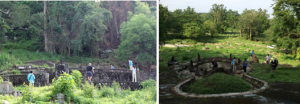
– (Left) As you walk up the hill towards Ng Boo Bee’s majestic tomb, you’ll see the 3-levels of the stone platform, which looks like a fort (photo by Bianca Polak) – (Right) The View from the back of Ng Boo Bee’s tomb (photo by Raymond Goh)
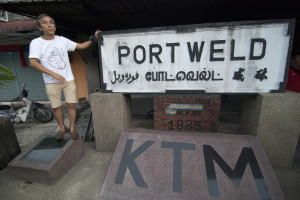
Our guide Ah Kew explains Ng Boo Bee built the first railway in Malaya for the British at Port Weld (photo Simone Lee)
Kwantung Cemetery Kwangtung Cemetery contains burials mostly of Cantonese and Hakka residence.
Taiping War Cemetery The fallen soldiers who defended Malaya from the invading Japanese forces were interred in this cemetery. There are 3 sections of the cemetery; the Christians (on one side of the road), the Muslims and Indians (on the other side of the road).

(from left to right): A tombstone for an Indian soldier, view of Christian side of the War Cemetery, and a tombstone for an English soldier (photo Simone Lee)
Amongst over 850 tombs are tombs of 4 volunteer soldiers. Three of them, Lim Poh Ann, Tang Bee Choon and Ong Kim Sai, were sent to fight in Singapore where they died. After the war, their bodies were returned and given a soldier’s burial.

– (Top row) The 4 fallen soldiers who volunteered to defend our land. – (Bottom row) Lim Poh Ann, Ong Kim Sai and Tang Bee Choon were sent to Singapore, where they were killed in action (photo Simone Lee)
As more immigrants were brought in to work in the booming new town, many temples were built. A temple which has stood the test of time is the Sam Wong Yah temple. The temple was built by Loke Yew, a millionaire and philanthropist who came to Singapore to seek his fortune. He started work at a provision shop at Market Street until he saved enough to open one of his own. He then travelled to Taiping to explore the tin mining businesses. However, he did not do well and was soon broke. He sought shelter at the hut housing the Sam Wong Yah deities. One night, in a form of a white figure, he dreamt of the deities advising him to go further south to strike it rich. And strike it rich, he did. He returned to Taiping to build the temple around the hut where he had taken shelter.
In Singapore, a road was named after him (Jalan Loke Yew, opposite of the Peranakan Museum at Armenian Street) in honour of his contributions while the Cathay Gallery at The Cathay (founded by Loke Yew) showcases the history of the building and the Loke family.
Matang Museum aka Ngah Ibrahim Mansion Ngah Ibrahim succeeded his father, Long Jaafar as the Malay chieftain of Larut. He fortified his mansion by building thick brick walls around it, resisting the violence between the Ghee Hin and Hai San fights. Part of the wall was damaged by a Japanese war plane which crashed into it. In the mansion are stories and artifacts belonging to Ngah Ibrahim and showcased what the mansion was used as after Ngah Ibrahim was exiled in Seychelles. He was never allowed to return and died in Singapore (1887). In 2006, his remains were exhumed from Masjid Al-junied and reinterred in the compound of his grand old mansion which now is the Matang Museum.
Other Attractions

Taiping Lake Gardens, originally a mining ground, is the first public garden in Malaya since it’s conversion in 1880. The beautiful 120 year old rain trees line the road around the lake have been a hot subject as nature lovers fight to save them from urban threats. (photo Simone Lee)
Upon our return in Singapore, a fellow member of the Heritage Singapore – Bukit Brown group asked, “did you guys do anything else in Taiping but eat?”, questioning the amount of food postings (and food) we had on the our Facebook pages. We certainly did and visited many more places apart from the ones featured in this write-up but there is simply too much to write in just one post. Besides, the best way to learn more about a place is to be there in person. There are many more that we didn’t get to explore. We certainly fell-love with Taiping’s charm and hope to go back in the near future. If you do plan to visit Taiping, do contact Lee Ah Kew through http://ahkew.blogkaki.net Ah Kew is a freelance writer and field historian, whose knowledge and collection of folk stories would enhance your experience at Taiping. Ah Kew’s article on the Brownies 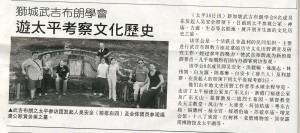

***********************
Editor’s note: If you have enjoyed Simone’s blog post and photo essay, do leave a comment and encourage her to do more. She is the “official” brownie travel concierge
“Ullambana” Festival by Bukit Timah Seu Teck Sean Tong @ Tangling Halt.
by Sugen Raniah
The Ullambana Festival is observed and celebrated by the Buddhists during the Seventh Lunar Month. The Sanskrit term, ‘Ullambana’, refers to the compassion for all beings suffering in the realms of misery. The observance of this festival is based on a discourse by the Buddha – where Maudgalyayana, a disciple of the Buddha, discovers that his mother, Lady Niladhi, had been reborn into the realms of misery. The troubled Maudgalyayana then seeks the Buddha for help. The Buddha advises him to make offerings to the Sangha, as the merit of doing so would help relieve the suffering of his Mother, and that of other beings in the same state.
Here in Singapore, it is a common sight for Teochew sian t’ngs (temples) to perform these rituals during the seventh lunar month. I observed and documented the Ullamabana Festival at Tanglin Halt Market and Hawker Centre by the members of Bukit Timah Seu Teck Sean Tong.
There are three temporary ceremonial altars set up in the tentage – the main altar of the three Buddhas, the altar for the Patron Deity, Du Di Gong and the last for Da Shi Ye (King of Ghosts). Offerings of dried goods and drinks, vegetables, a variety of meat and paper offerings are assembled in the centre of the tentage. Here associate members of the market and members of public are invited to offer joss sticks to the wandering spirits. There are also smaller areas around designated for the spirits for ‘lodging’, ‘washroom’ and ‘leisure’ purposes.
Unlike the elaborate Taoist salvation rituals by Xuan Jian Dian, the Buddhists embrace the recital of Ulka Mukha Sutra. Men, draped in red vestments, are represented as the Sangha (the community of disciples). The Sutra recited is an amalgamation of the mind, body and mouth. Mind in absolute contemplation, with hand gestures of the mystical Mudras and together with the recitation of esoteric words of the Sutras- they invite the wandering spirits to listen to the teachings of Buddha and liberate them from all sufferings. These men sing the Sutra in Teochew and the lyrics are accompanied by beautiful Teochew styled music. It is meant to work like a beautiful charm that draws the spirits to listen and attain liberation.

The ‘Sanghas’ paying homage to the Patron Deity of the market and hawker centre – Du Di Gong (photo Sugen Ramiah)
The day ritual comes to a close with the tossing of longevity buns. The food offerings are then packed and distributed to contributors and friends. Members of the temple take a break before preparing for the dance of the auspicious lanterns later in the evening.
****
Sugen Ramiah a teacher by training, has been observing and documenting Chinese festivals and rituals conducted by temples for the past one and half years.
More on the Hungry Ghost Month from Sugen here and here .
Singapore is 49 and Bukit Brown is 92! The invitation went out weeks before on the blog, on Facebook, the event of the year at Bukit Brown, celebrating the nation’s birthday. Thank you to all who came, regulars, first timers, old and young, singers and well wishers. The official NDP’14 theme was a good fit :
NDP ’14 (Nations Deceased Pioneers) @ Bukit Brown this year honours the “can do” and caring spirit of our pioneers who helped to forge bonds which built the foundations for SG 50. It is the story of how “Our People” in Bukit Brown made Singapore, “Our Home”.
We promised 3 guided walks, goody bags, eats and music. But the highlight as always is the singing of the National Anthem – this year led by Brownie Mil Phuah, the reciting of the Pledge – this being Raymond Goh’s first ever NDP@Bukit Brown (previous years he was away on business trips) it fell on his shoulders, followed by a minutes silence to remember especially the 4,153 pioneers who have had to make way for the highway. Our resident videographer James Tann captured an NDP on the celebratory Hill 1 festooned by flags large and small, and the pride of over 50 voices.
It has been a momentous past year for Bukit Brown from being on the World Monuments Fund watchlist to be being voted by Singaporeans as their top 3 sacred sites . The good news continued as Claire Leow, co founder of All Things Bukit Brown, shared some more developments .
“We are humbled and honoured to announce that thanks to the nomination by the Singapore Heritage Society, all things Bukit Brown has been shortlisted for the inaugural Singapore Advocacy Awards 2014, under the category of Civil Society Advocate Organisation of the Year.
The winner will be announced Aug 30, but let us say now for the record, just being nominated has been a real honour as a recognition of all that this community has achieved since early 2012.
To date, the Brownies have guided more than 12,000 people, staged two exhibitions, and tried to connect descendents, academics, students and teachers, docents, heritage bodies and communities. We don’t always succeed but we surely give everything a passionate shot! Your unstinting support as a community has sustained us. We have guided rain or shine or exhumations. Behind the scenes, many work hard to raise awareness of the intrinsic value of this historic site, and a few have worked patiently with the authorities for a better outcome.
We thank all of you for your support in our endeavour. It is an understatement to say it has not been an easy mission. But driven by conviction, we have carried the heart of this community. We have become good friends, and made good friends. Inspired by the early groundwork laid by Raymond Goh and Charles Goh, the Brownies have built on a solid foundation to spread the word: this is our heritage, habitat and history – and we appeal to you to join us, and honour our pioneers and save this sacred site.
On this, the 49th birthday of Singapore, we say, Majullah!” Claire Leow, Co Founder, All Things Bukit Brown.
***
Bukit Brown was also highlighted in the national daily Today August 9th Special issue Preserving Memories of a Changing Nation
“In 2012, the two women created a blog, all things Bukit Brown, to provide a platform for people to share memories of the area as well as to raise awareness of the walks they were planning there. Since then, the blog has garnered more than 550,000 views and more than 4,000 members on its Facebook page.
With the help of 40 volunteers called Brownies, the two women have also guided more than 11,000 (now 12,oo0)people on their Bukit Brown heritage trails.
“This shows we made the right move and have won the hearts and minds of the public,” said Ms Lim, now a freelancer in broadcast media. She attributed the positive response to the blog and heritage trails to more than just nostalgia. “It’s a much deeper meaning — a yearning, post- sickness, when old places have to move for new ones.”
Since 2012, all things Bukit Brown has also added a unique twist to the National Day celebrations: While others get ready for the National Day Parade, its members have their own National Deceased Parade. This year, they plan to go on a heritage trail in Bukit Brown to commemorate Singapore’s pioneers for their resilience, contributions to and sacrifices for the country.”
****
Here are highlights from the different heritage trails, behind the scenes set up and the camaraderie and conviviality that took the celebrations from dusk to moonlit night. Thank you to all who came, regulars, first timers, old and young, singers, photographers and well wishers. the Brownies are grateful for your support. Here are your memories:
The Guided Walks by Claire, Bianca, Fabian, Simone and Walter

埋骨何須 故里 盖棺 便是吾盧 Why is it necessary to bury my bones in my ancestral land? The place where my coffin is sealed is my home Tan Ean Kiam, on his tomb at Bukit Brown(photo Philip Holden)
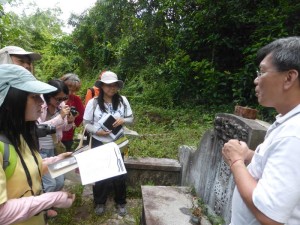
The Chinese Tour led by Walter Lim, had some Hongkong visitors, so Cantonese was also the lingua franca of the day (photo Victor Yue)
Behind the Scenes, A Team of Brownies Setting the Stage for Celebration
Celebrations!
National Anthem as recorded by Albert Ong
Not Just Singapore’s birthday but 3 Brownie Birthdays in August!
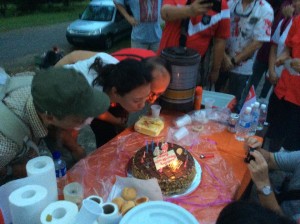
Left to right “Uncle Foo aka Garden Hill” 9 August, Simone Lee 10 August and Keng Kiat 11 August- HUAT AH! (photo Khoo Ee Hoon)
” Deeply reflective and moving National Day observance at Bukit Brown today, with graves already exhumed and half the site sectioned off for the road. There are some things that money can’t buy. A big thank you to Catherine Lim, Claire Leow and others!” Philip Holden.
A big shout out to those behind the scenes and catering:Brownies Victor Lim, Sugen, Mil Jonathan, Raymond, Ee Hoon, Peter, Steven, Mitch, Andrew and tombkeeper Lim Ah Chye. To Lee Kok of Asia Pac Publishers for contributing goodies to goody bags, National Heritage Board for the bags and National Library Board for commemorative books on Khoo Seok Wan.
Preamble : Hungry Ghost Festival
Saturday, 26th July was the eve of what is popularly known as the Hungry Ghost Festival, and less well known by its traditional name of Zhongyuan Jie, which in essence is also about honouring ancestors. It takes place at the start of the Chinese 7th lunar month, and it is when the gates of hell open and the spirits of dead are free to wander among the living for a month. To appease them, offerings and entertainment is laid out by descendants at their homes, but also by temples, business and clan associations. This year, the prediction was that hell’s gates will open at 11pm on the eve of the festival.
The Salvation Rituals
At Bukit Brown, devotees from the Taoist temple Xuan Jiang Dian (Heng Kang Tian ) conducted a “chao du” or “salvation rituals” – considered an act of compassion – specifically for the forgotten and lost spirits there.
This is the 3rd year in a row, Xuan Jiang Dian have done this, ever since in fact news of the building of the highway across Bukit Brown in 2011 was announced. Exhumations of the some 4.153 graves which are in the way of the highway are drawing to a close. So there was added interest in this year’s ritual which was covered by our national newspapers. The National Heritage Board (NHB) shared that a specially commissioned video on rites and rituals at Bukit Brown will be uploaded soon to you tube.
A First Hand Account of “chao du”
The ” chao du” ceremony which was witnessed also by Brownies and other well wishers, started at around 8.3opm . It consisted of the setting up of an altar table with offerings at the major junction of the 4 roads in Bukit Brown which leads to Blocks 1, 5, 4 and 3.
The Taoist priests from China, resplendent in their robes, chanted and walked several ceremonial rounds in the area calling upon lost spirits. There was something soothing in their chanting and the air was redolent with the scent of what must have been a hundred lighted joss sticks. Each participant carried 3 sticks each throughout the 40 minute long chanting.
There was a stillness in the air and the smoke and swish of the robes carried the movement of the night. It ended with the burning of paper offerings and just as quickly as it was set up, the devotees packed up and left, with the the candles planted still burning and the last vestiges of the paper offerings smouldering down to embers.
******
Photo Gallery :

Side View : Off site 3 tablets, set up by Xuan Jiang Dian at Bukit Merah Blk 123 for the wandering spirits of Kopi Sua aka Bukit Brown. [right] for animals killed during agricultural activity (prior to it becoming a cemetery)[centre] for wandering souls[left] for animals killed during construction works (photo and caption by Chua Ai Lin)
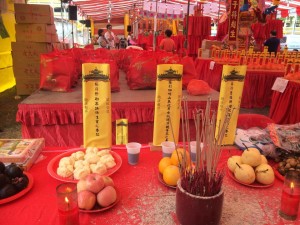
Front View : Off site 3 tablets, set up by Xuan Jiang Dian at Bukit Merah Blk 123 for the wandering spirits of Kopi Sua aka Bukit Brown. [right] for animals killed during agricultural activity (prior to it becoming a cemetery)[centre] for wandering souls [left] for animals killed during construction works (photo Raymond Goh)
Report on Lianhe Zaobao on a ritual conducted last night at Bt. Brown which marked the opening of the 7th month: A group from Heng Kang Tian including 8 Taoist priests conducted the ritual to invite spirits to a salvation ceremony conducted today in front of Bukit Merah View Block 123. The group has been going to Bt. Brown for the past two years to invite spirits from tombs which are not tended to by descendants. The event was attended by Brownies and participants of tours at the cemetery. It was also recorded by the Bt Brown Documentation Team. NHB is currently preparing a 10-15 min documentary on the rituals carried out at Bt Brown cemetery. This will be uploaded to the NHB channel on youtube, “yesterdaysg”, around end next month. (summary by Ang Yik Han) Full report in Chinese:
文物局到武吉布朗坟场 记录“招魂”仪式
王舒杨
联合早报2014年07月27日
今天是农历七月初一,华人传统节日“鬼节”今起开始。昨晚,武吉布朗坟场文史记录小组和国家文物局人员特地到武吉布朗坟场,记录一场由道教团体进行的祭祀仪式。
昨晚约9时,应道教宗教团体玄江殿邀请的八名道长和一名唢呐乐师在武吉布朗坟场进行“招魂”仪式。在道路两侧点亮“引魂”的香火后,他们在锣鼓声中唱诵经文。今明两天他们将在红山景第123座前的道场举行大型超度法会。
数十名积极参与保护武吉布朗文化遗产的公民团体成员也到场目睹仪式。除了这些“武吉布朗人”,不少报名参加坟场导览活动的外国人和游客也纷纷拿起相机拍下这个独具特色的活动。
玄江殿自1996年起多次在武吉布朗坟场举行农历十月初一的“寒衣节”祭祀活动,并从两年前开始在武吉布朗坟场举行七月鬼节的法事,目的是在坟场进行招魂,为他们超度。
根据武吉布朗坟场文史记录小组整理的资料,武吉布朗坟场里的中元节如同一项社区活动,是一种灵界上的慈善事业。信徒所祭祀的亡魂通常与他们没有任何亲属关系,尤其是孤魂。
玄江殿主持陈荣兴(45岁)说,武吉布朗一些坟墓主人没有子孙祭拜,所以希望能为这些孤魂超度。
此外,道家也相信所有生灵皆可超度,而坟墓挖掘过程中伤到蚂蚁等生灵,超度法事也怀有对它们的尊重。
国家文物局目前正在筹备一个10至15分钟长的纪录片,介绍华人社群在武吉布朗坟场的仪式,包括七月鬼节、清明节以及较少人知道的寒衣节。短片料下月底上载到文物局的YouTube频道“yesterdaysg”。
文物局总司长(政策)陈子宇说:“武吉布朗坟场不仅仅是一个埋葬地点,也是华人社群进行祭祖等仪式的地方。我们会记录这些仪式,以继续丰富我们有关新加坡非物质文化遗产的数据库。”
公众可通过在国家图书馆大厦9楼展出的“武吉布朗:记录新知识 开拓新视野”中英文展览,了解武吉布朗坟场上世纪的演变、坟墓设计和民间风俗等。图书馆大厦展览在10月10日结束后,将陆续在宏茂桥、裕廊、蔡厝港和大巴窑图书馆展出至明年1月底。








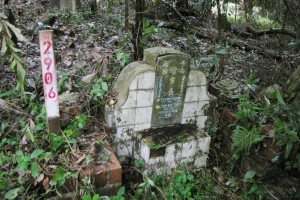
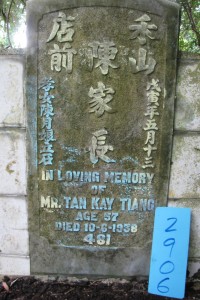

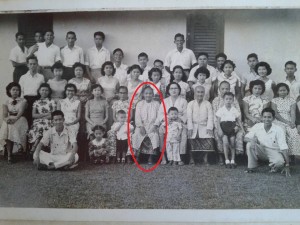

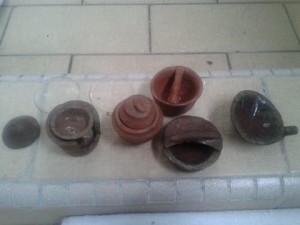








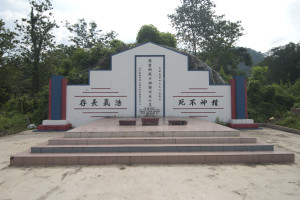
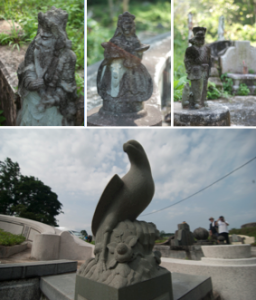





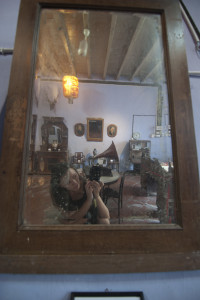
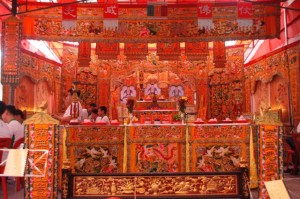
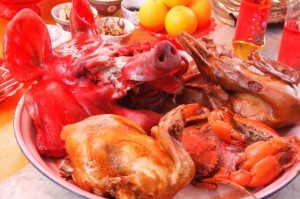

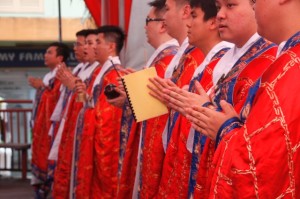
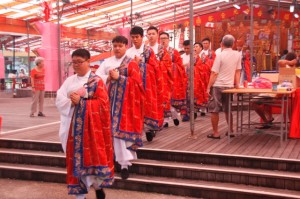
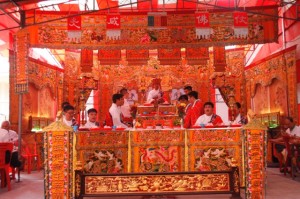

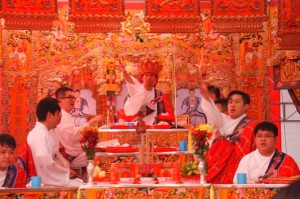
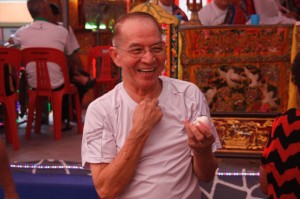
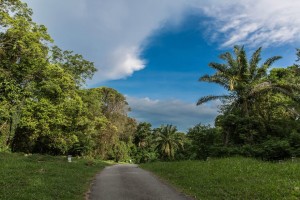
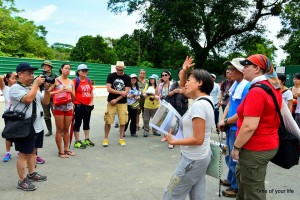


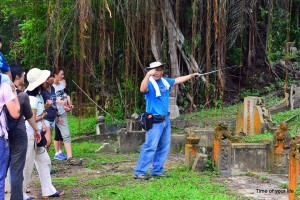
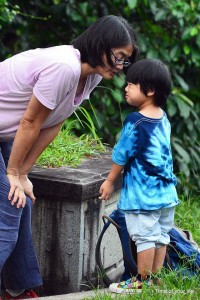

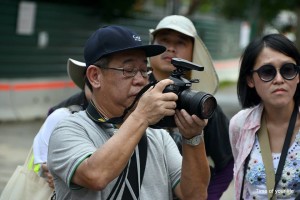
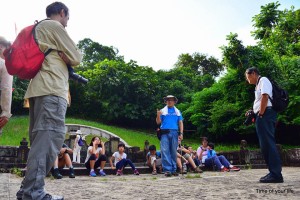
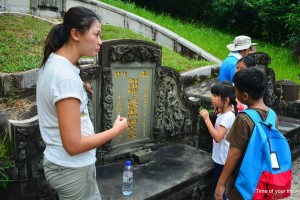


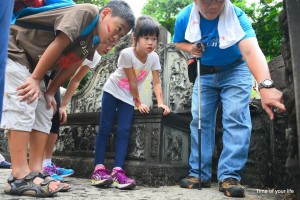
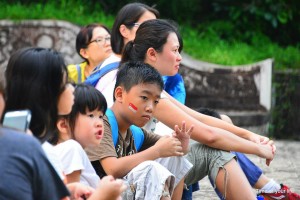


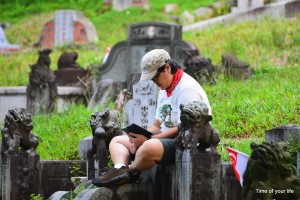

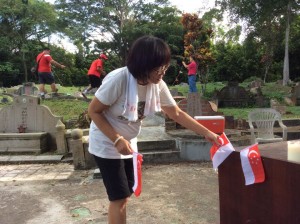
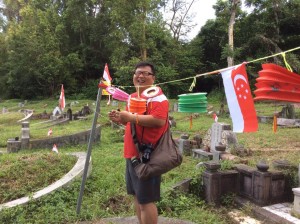
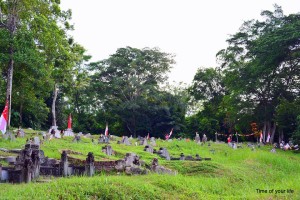
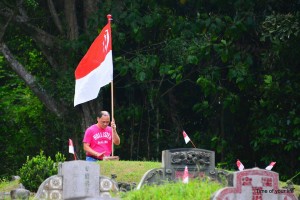
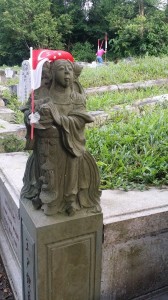

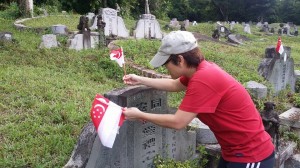
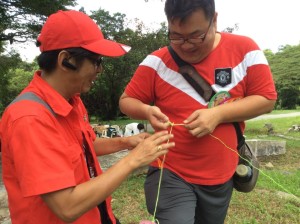
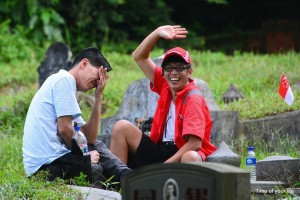
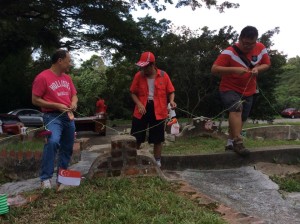
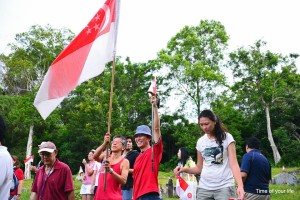
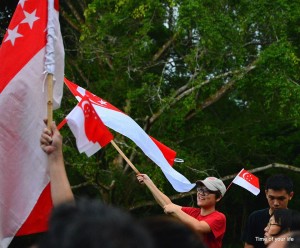

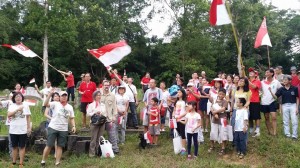

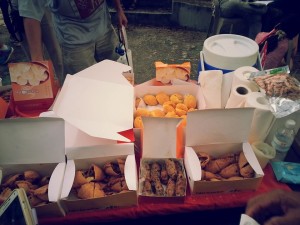
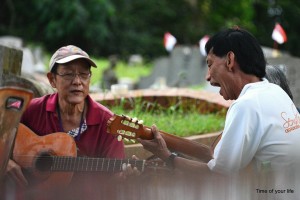
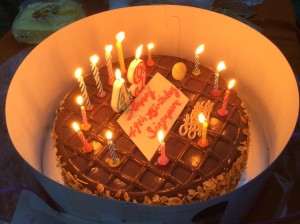
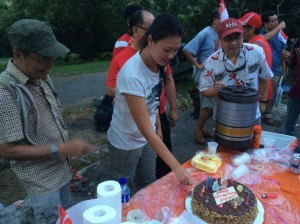

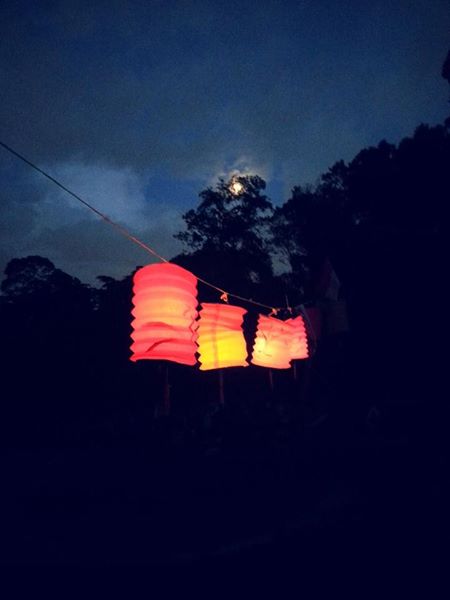
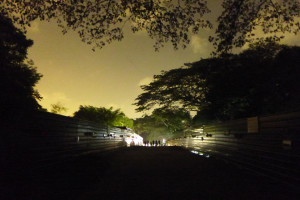
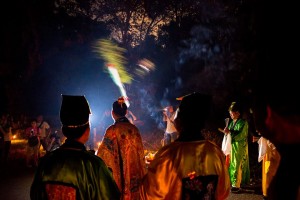

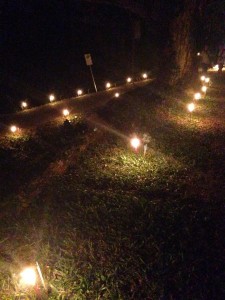
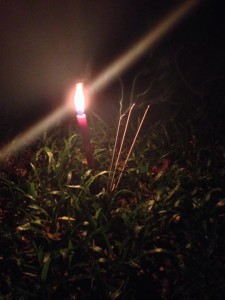
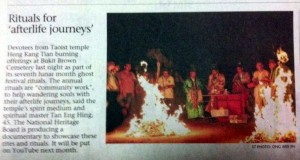
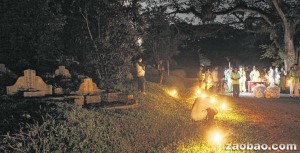
Recent Comments